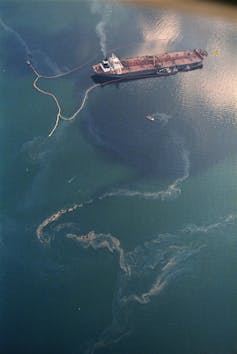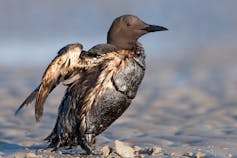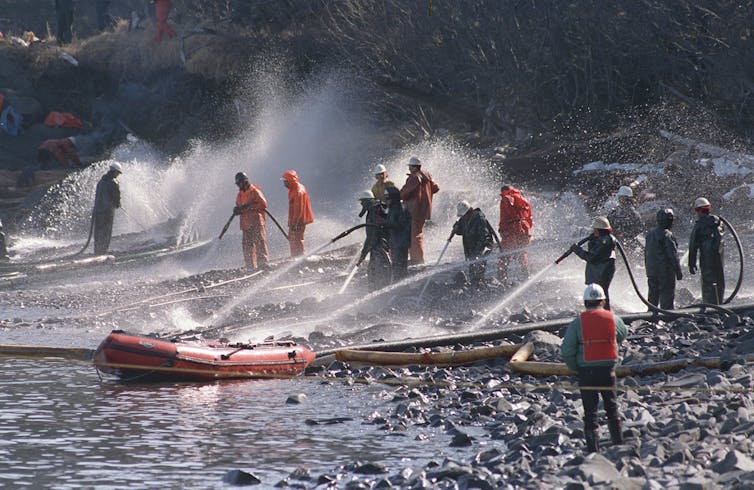By Jennifer Provencher and Yasmeen Zahaby
This article is republished from The Conversation under a Creative Commons licence. All photos provided by The Conversation from various sources.
When we think about the Arctic, most of us think of a snow-covered barren landscape and vast stretches of icy ocean. This is far from the reality of the Canadian Arctic today. With approximately 150,000 people calling it home, this region is certainly not barren.
The Arctic is warming faster than anywhere else on Earth. This stark increase in temperature affects wildlife, plants and humans and results in less sea ice, which many predators and hunters use year-round.
The loss of sea ice is also making the North more accessible than ever, thus increasing the probability of major oil spills as ship and tanker traffic multiplies. These spills expose the wildlife to new contaminants, including polycyclic aromatic compounds — the main contaminant in oil spills — which can cause cancer in birds.
This influx of new contaminants in the environment makes it challenging for researchers to monitor their effect on wildlife. After studying ways to monitor the quantity and variety of contaminants in Arctic wildlife, we have created a new tool — ToxChip — to analyze changes in the DNA of animals exposed to oil and solve this challenge.
Increased oil exploration and extraction
Between 1995 and 2015, shipping traffic nearly tripled in the Canadian Arctic due to depleting sea ice. Newly accessible shipping routes, including the Northern Sea Route, cut transit time between East Asia and Western Europe by about 10 days.

(AP Photo/John Gaps III)
As the Arctic contains around 13 per cent of the world’s unexploited oil, the race to claim this precious resource is on. Unfortunately, more extraction and shipping in the Arctic will inevitably lead to more oil spills.
The infamous Exxon Valdez spill in 1989 discharged nearly 37,000 tonnes of crude oil into Alaska’s southern coast, killing over 30,000 birds.
More recently, a fuel tank at a power plant released 20,000 tonnes of diesel into the Ambarnaya river in Russia in 2020.
The main compounds found in oil and petroleum products called polycyclic aromatic compounds, or PACs, can harm birds in the marine environment. When emitted through exhaust or spills, these chemicals make their way into wildlife and plants in the area. They easily attach to fat in animals and can accumulate in them throughout their lifetime.
Birds reveal environmental contaminants
Seabirds are especially vulnerable to the effects of oil, as they feed on the water surface. Oil can coat a bird’s feathers, making them unable to fly or regulate their temperature.

(Shutterstock)
Birds also clean their feathers with their beaks, which introduces oil into their digestive system. Oil and petroleum products also affect birds, causing stunted limbs, reduced breeding and population declines.
In fact, there are documented long-term effects on ducks, whose survival rates were lower compared to non-oiled birds for at least 11 years after a spill.
ToxChip: New technologies can help track contaminants
Each gene in an animal’s DNA contributes to a specific natural function. Some genes are responsible for regulating an animal’s metabolism, while others take care of suppressing tumours. Therefore, if a specific gene is induced after exposure to a contaminant like oil, we can tell what biological processes have been affected.
Changes in an animal’s gene expression — ability to convert DNA instructions into functional products, like protein — can tell us a lot about how it responds to a specific chemical, or group of chemicals. Current methods to measure the contaminants in animals are costly, rely heavily on lab animal use and can only measure the effects of one contaminant at a time.
We have developed a new tool called a ToxChip, which investigates the effects of contaminants on the DNA level in sensitive genes. It can quickly detect changes in the genes of seabirds in response to a contaminant. The ToxChip can be customized to species, contaminants and genes of interest.
So far, we have developed two ToxChips: one for the black guillemot and one for the thick-billed murre. These seabirds nest on rocky cliffs which serve as breeding grounds.
The guillemot doesn’t stray far from its colony and feeds on fish close to the shore. The thick-billed murre, on the other hand, can travel far from the colony and is known for diving deep into the water to catch their prey.
Both species are far from endangered and their colony populations can reach the millions, making it possible to determine the extent to which contaminants are affecting the birds. As these birds are heavily reliant on open-water food sources, an oil spill could quickly be detrimental to the entire colony.
ToxChips can be applied following an oil spill to quantify potential sub-lethal or irreversible damage. Different types of PACs can tell us where they come from. PACs from forest fires will have a different chemical make-up than PACs from an oil spill. This ToxChip data allows us to determine the cause of toxicity to seabirds.
Through a recent use of the ToxChip, we were able to determine the likely effects from a natural oil seep off the coast on Nunavut.
A cheaper, faster and more affordable solution
The future applications of this tool are vast and promising. It can help look at the effects of pesticides on bullfrog’s DNA or the impact of plastic pollution on the biological processes in pink salmon and so on. Species-specific ToxChips can help shape evidence-based policy recommendations or monitoring initiatives that would limit vessel traffic in endangered bird areas during the breeding season.
Monitoring contaminants in wildlife is particularly important to those who rely on local country food. Using these tools can help inform those living in the Arctic if the animals they depend on have been exposed to contaminants.
They can be used as an emergency response to an oil spill. Oil can linger long after the clean-up crews have removed the visible oil from the environment. ToxChips can help understand if seabirds continue to be exposed to oil pollution.

(AP Photo/Rob Stapleton, File)
While the tool is still evolving, it has been developed for two seabird species and is being put into practice currently to assess gene expression changes after a large oil spill and at an old military site with known contamination.
ToxChip projects will make contaminant testing more affordable, more accurate, faster and less dependent on lab animals. It could help reduce the impacts of oil pollution on animals in the future.
![]()
Sunday, May 8, 2022 in The Conversation
Share: Twitter, Facebook



